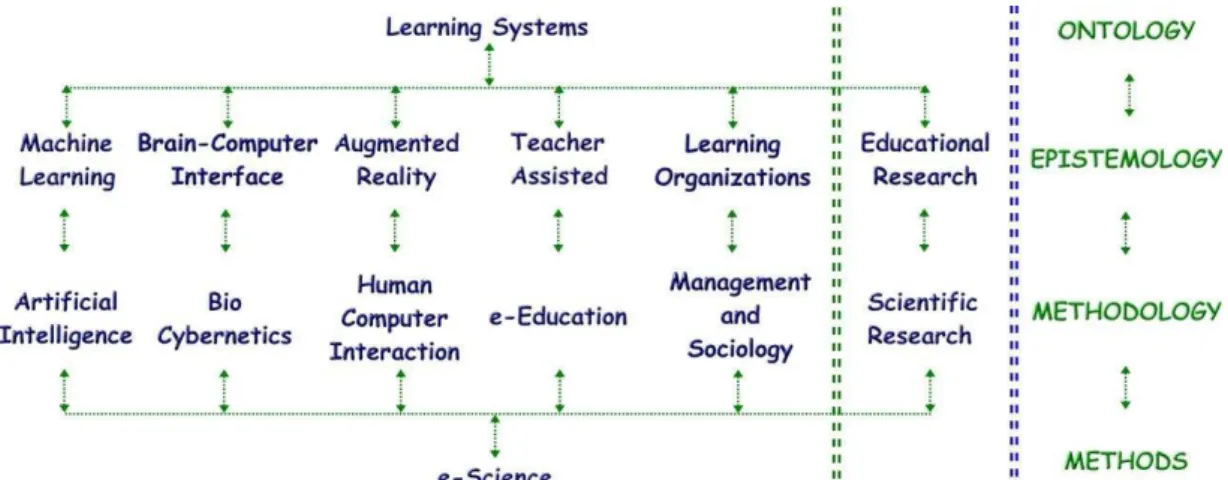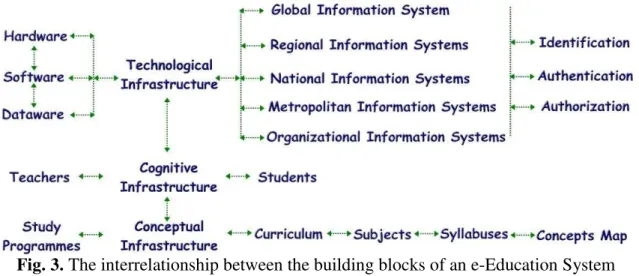Assisted Learning Systems in e-Education
Gabriel ZAMFIR
Department of Economic Informatics and Cybernetics, The Bucharest University of Economic Studies, Romania,
gabriel.zamfir@ie.ase.ro
Human society, analyzed as a learning environment, presumes different languages in order to know, to understand or to develop it. This statement results as a default application of the cognitive domain in the educational scientific research, and it highlights a key feature: each essential discovery was available for the entire language compatible society. E-Society is constructed as an application of E-Science in social services, and it is going to reveal a learn-ing system for each application of the information technology developed for a compatible so-ciety. This article is proposed as a conceptual one focused on scientific research and the in-terrelationship between the building blocks of research, defined as an engine for any designed learning system applied in the cognitive domain. In this approach, educational research be-come a learning system in e-Education. The purpose of this analysis is to configure the teach-er assisted learning system and to expose its main principles which could be integrated in standard assisted instruction applications, available in e-Classroom, supporting the design of specific didactic activities.
Keywords: Research Methodologies, Educational Research, E-Science, E-Education Infra-structure, E-Classroom
Introduction
The analysis of this study is built on the paradigm of the triangle lexical, terminologi-cal and conceptual approach, presented as a three layers research methodology for an ed-ucational environment. A case study is start-ed for the word ‘society’, which lexically, has a multiple common-sense meanings. The most abstract sense of it is concentrated in
expressions such as “the information socie-ty”, “the knowledge society” or “the learning
society”; in this case, the perspective is the cognitive domain and no limitations are in-cluded. These are different representations of the same global community, and as another lexical exercise, globalization is used to de-scribe the international community by the us-ers of the global information system and to explain the international community by the designers of the same society. The three senses are reflecting the first three stages of the Bloom taxonomy: knowledge, compre-hension, and application. We use these three concepts as a building block for a learning system, and as a scaffold of the pyramid of specific terms. Passing the lexical level, we develop a terminological analyze, in a
socio-logical approach, where [1] concludes that the common-sensical meaning of ‘society’ have three features in common: first, each re-fers to networks of people relating to each other in some meaningful way, even if indi-rectly; second, there are criteria of member-ship, and therefore there is some sense of in-clusive – and therefore necessarily exclusive
– boundedness; and third, each conveys a sense of ways of doing things in common, of characteristic patterns of behavior, of organi-zation. For an educational approach, this rep-resents the two next stages of the Bloom tax-onomy: analysis and synthetizing using the
network’s terms of the domain. These
mean-ings of ‘society’ also suggest that there is
widespread recognition that there is some-thing more for everyday life than the embod-ied obviousness of individuals. The same au-thor considers that talking about how we can perceive the collective more-than-the-sum-of-the-parts move the discussion on the epis-temology: how are we to know and under-stand the human-made world? In the educa-tional approach, at this level, we identify the sixth stage of the Bloom taxonomy: evalua-tion, in order to intend a scientific
ogy for an educational research. Before an-swering that question, [1] considers that it is necessary to clarify the relationship between ontology and epistemology.
According to [2], there are several reasons for wanting to have a clear and transparent knowledge of the ontological and epistemo-logical assumptions that underpin research: first, to understand the interrelationship of the key components of research, including methodology and methods; second, to avoid confusion when discussing theoretical de-bates and approaches to social phenomena; and third, to be able to recognize others’, and defend our own, positions. Ontology is the starting point of all research, after which
one’s epistemological and methodological
positions logically follow. In [3] the author explains that there are two distinct but related senses of the word ontology: its technical computer science sense, associated with the World Wide Web, and its technical philo-sophical sense; when confusion is possible,
the first is called “computer” or “computa-tional” ontology, and the second “philosoph-ical” or “formal” ontology.
Knowledge, and the ways of discovering it, are not static, but forever changing. Continu-ing the idea, [4] highlights the fact that epis-temology sustains the researcher to generate knowledge and explanations about the onto-logical components of the social world, be they social processes, social actions, dis-courses, meanings, or whatever, which he has identified as central. There may be lots of possibilities and, the researchers must recog-nize not only that there is more than one epis-temology, but also that they will not all be complementary or equally consistent with their own ontological position. At the same time, starting from the definition of
‘termi-nology’, [5] concludes that we can realize
clearly that this word is connected with spe-cific subject field, and it can be describe as a structured set of concepts that clarify and put bases for a particular subject field or as an in-frastructure of specialized knowledge. The same author focuses on exposing the impact of the lexical problems upon translation of the economic terminology. Lexical problems
usually occur when the meaning of the word or the expression in the language is not un-derstood, or totally were unknown terms to the translator, synonymy, polysemy, colloca-tions, metaphors and idioms are the most common lexical problems. A complementary perspective of the analysis is investigated in [6]; the author aims to show, in a summa-rized way, how different studies on metaphor can positively converge to a cognitive-linguistic perception of this phenomenon. It is concluded that metaphor is one of the phe-nomena that make part of the technical and scientific communication and, because of the complexity in approaching such topic, it must also investigated in Terminology. It is recog-nized the existence of two possible ap-proaches on metaphor: the rhetoric concep-tion and the semantic concepconcep-tion. The meta-phoric neologisms that integrate a specific terminology are related to the process of cre-ative analogical thinking. These neologisms, or neolexicalizations, would be a result of deep analogies used to creative understand-ing or didactic purposes.
As indicated by Greek etymology, metaphor
means “transference” and lead us to
methodolo-gies for a learning system. In an e-society, knowledge and cognitive infrastructures are two applications of e-science, first in tech-nology and the second, in the educational in-frastructure, as they are presented in the par-adigm of learning in a scientific environment [8]. The same paradigm presents knowledge and cognitive infrastructure as other two ap-plications of Terminologies, first in a specific language and the second, in a particular con-cept map. In this context, learning is defined as an application of a cognitive infrastructure in knowledge, in order to convert tacit knowledge in explicit knowledge.
Analyzed as a human-made world, a learning society requires a language with a triple phase for a concept within a terminology us-ing a lexicon: knowledge, comprehension, and application.
2 Knowledge Framework
Based on the same methodological approach presented in [8], scientific research is defined as a paradigm between theory and practice, developed for an object language using an updated meta-language. The possibility of using the same term in the group of the work-ing terms and in the group of the scientific
field’s terms lead to the situation of describ-ing or explaindescrib-ing a paradox. In fact, these are the two functions of the meta-language, which represent the first two stages of learn-ing: knowledge and comprehension. The third stage, the application is implemented as a pattern of the object language. Technologi-cal innovation in a digital environment de-pends on the pattern of educational change in the pedagogical environment, when this is an application of the technological infrastruc-ture.
The idea of an innovative learning system was published in 1950, when [9] mentioned in the introductory section that the paper was concerned with the problem of constructing a
computing routine or “program” for a
mod-ern general purpose computer which will en-able it to play chess. The author considered that although perhaps of no practical im-portance, the question was of theoretical in-terest, and it was hoped that a satisfactory
so-lution of this problem will act as a wedge in attacking other problems of a similar nature and of greater significance. There were listed directions as: machines for designing filters, equalizers, relay and switching circuits, ma-chines which will handle routing of tele-phone calls based on the individual circum-stances rather than by fixed patterns; ma-chines for performing symbolic mathematical operations, machines capable of translating from one language to another, machines for making strategic decisions in simplified mili-tary operations, machines capable of orches-trating a melody, and machines capable of logical deduction. In August 2013, at Yoko-hama in Japan it was organized the 20th World Computer Championship. There were two main tournaments: an unlimited hard-ware World Computer Chess Championship and an equal hardware World Chess
Soft-ware Championship
(http://www.hiarcs.com/Games/wccc13/wccc 2013.htm).
In 1983, in [10] it was mentioned that Ma-chine Learning was been a constant theme
throughout AI’s two decades of existence. In
this overview the authors were analyzing var-ious aspects including the major methodolog-ical approaches advocated in Machine Learn-ing research, and how they had related to
ma-jor contemporary themes in “mainstream” AI
Research. According to the authors, learning is a many-faceted phenomenon. Learning processes include the acquisition of new de-clarative knowledge, the development of mo-tor and cognitive skills through instruction or practice, the organization of new knowledge into general, effective representations, and the discovery of new facts and theories through observation and experimentation. The study and computer modelling of learn-ing processes in their multiple manifestations constitutes the subject matter of machine learning.
In 2014, in [11] the author’s main research
applica-tion of cybernetics in science, as soon as cy-bernetics was formulated by its founders as a meta-discipline with the aim of collaboration between disciplines (inter-disciplinary) and of sharing knowledge across disciplines (trans-disciplinary). As meta-discipline, cy-bernetics integrates ontology as forms of knowledge and epistemology as forms of knowing. One example of this approach is the Brain Gate Neural Interface System de-veloped to sense, transmit, analyze and apply the language of neurons. Two applications of the Brain-Computer Interface as learning sys-tem are: activating control of mobile robot by human brain electrical activity and evaluating the machine learning procedures [12]. This situation reflects the computer as a physical extension of the human brain. A second ex-ample of the integration of forms of knowledge and forms of knowing is repre-sented by augmented reality, where the com-puter is reflected as a psychological exten-sion of the human brain. In this case, aug-mented reality can be used to encourage un-derstanding and mastery of the real world therefore resulting in an augmented percep-tion of reality as it exists in the present; at the same time, augmented reality can propose an artificial environment that represent some past or future reality, or even an impossible reality [13].
The third example of this approach is repre-sented by the personal computer as a cogni-tive extension of the human brain, and the system is a teacher assisted learning. As it is analyzed in [14], the learning system based on a teacher assisted activity is a dynamic one and the concept is developed on three kinds of infrastructure which are likely to emerge: first, technological infrastructure, the second, cognitive infrastructure of all par-ticipants involved in the teaching-learning activities, and the third, conceptual infra-structure of the type of the study pro-grammes. Technology determines new forms of knowledge and new forms of knowing too. As a consequence, all three type of
infra-structure are dynamic and each of them need systematic updates. This is an explanation for developing standards for hardware, version-ing policy for software, and definversion-ing standard professional and transversal competences for academic qualifications. Such an approach transforms the academic institution into a learning organization, and its infrastructures become compatible with standard economic, cultural, and political institutions.
3 Comprehension Framework
Social relations identified as communities, organizations, institutions, and societies are conceptualized as sets of interrelated parts with internal structures and processes. Ana-lyzed as evolutionary entities, they become systems and represents more than the sum of its parts. Developed in an educational re-search, standard internal structures define learning organizations and standard process-es define organizational learning. Three typprocess-es of learning were identified in such a context: learning to adapt, learning to change and learning to learn. As social constructs, three type of educative systems were highlighted representing formal, non-formal and informal education. Developed as a global information system, the technological infrastructure trans-formed the educative systems in intranet, ex-tranet and internet environment.
Each component of this approach became an ontology of a scientific research activity, in-cluding research activity as a circular refer-ence. According to [2], by setting clearly the interrelationship between what the researcher thinks can be researched, linking it to what we can know about it and how to go about acquiring it, you can begin to comprehend the impact your ontological position can have on what and how you decide to study. A
re-searcher’s methodological approach
Fig. 1. The interrelationship between the building blocks of research
The same author highlights that the figure shows the directional, and logical, relation-ship between the key components of
re-search; what the figure doesn’t show is the
impact and the influence of the questions one is asking, and the type of the project one is undertaking, on the methods chosen. At the same time, the researcher may begin at any of the stages in the figure above.
According to the conceptual paradigm of learning in e-Society presented in [8], where e-science is defined as an application of the informatics technology in science, and syn-thesizing the approach developed in the knowledge framework in this paper, a projec-tion of learning systems in the context of the building block of scientific research is pre-sented in the image in Fig. 2.
Fig. 2. The interrelationship between the building blocks of Learning Systems
Scientific research activity, using a meta-language in order to explain the building blocks of research as different pieces of path-making, represents a recursive process for education, while scientific research activity, using an object-language, in order to describe different pieces of path-using, represents an application in e-science. As it was grounded in [15], both types of languages develop sub-jects in the background of a specific group of working terms, expanded as a meta-subject. The group of working terms has a double function: a descriptive one (knowledge func-tion) and an explanatory one (understand function).
4 Application Framework
As it was presented in [14], the conditions of a theoretical framework for the development of the e-education concept there were availa-ble in the middle of the last century. The premises of e-education were structured on
the three types of infrastructure: the techno-logical one (the first computer: programma-ble, digital, RAM based, transistor based, commercial, and even the personal one), the conceptual infrastructure (based on the in-formation technology domain) and the cogni-tive infrastructure (based on the Bloom tax-onomy). These three modules represent the context, the content and the cognition, devel-oped as the essential components of an edu-cational research model.
functionality (see the image presented in Fig. 3). The users consist of different classes, such as: teachers, students, tutors, designers, administrators and guests. They are educated based on different conceptual infrastructure, and promote different conceptual infrastruc-ture, permanently updated.
The main features of an e-Education system are determined by the global functionality and the diversity of the users. The technical components are developed by integration or aggregation, and the evolution of the system is a spiral one, as soon as these are drivers for human behaviour.
Fig. 3. The interrelationship between the building blocks of an e-Education System
The human-made world is a learning envi-ronment because of tacit knowledge. Educa-tion, as the engine of this learning environ-ment, has the responsibility concerning knowledge conversion. According to previ-ous researches [8], [14], and [16], in this ap-proach the e-education is defined as an appli-cation of assisted didactic design in educa-tion and e-learning is developed as an elec-tronic support for e-Class. E-Class represents
a virtual classroom, with no restrictions re-garding space and time, developed as an in-formatics application in e-Education based on e-Science. E-Classroom is developed as an alternative of this electronic space, repre-senting an extension of the traditional class-room and it is constituted as the first social application of the assisted instruction in e-Education based on e-Science.
Fig. 4. Learning Systems in e-Education
E-Classroom could be designed as a learning system when it is based on an architecture
stand-ardized professional and transversal compe-tences for academic qualifications, and standardized conceptual infrastructure for each type of the study programmes. All three types of conditions need periodical update. Factually, first two of these settings are rep-resented at least, by initial implementations, while a digital content developed as standard assisted instruction applications involving didactic laboratories capable to be used for creating learning objects remains a perma-nent objective.
E-Classroom integrates assisted instruction which consists of computer assisted instruc-tion and teacher assisted learning. Computer assisted instruction represents the basis for individualized learning, and integrates this first principle of the teacher assisted learning system. The second principle is derived from the first one; it is personalized learning which it based on the student-own-pace feature. This functionality is founded on interactivity, which is developed as the third principle of this type of learning system and it is based on the triple-vision of the personal computer as tool, tutor and tutee.
Interactivity depends on the adequate infor-mation granularity, which represents digital content developed in a concept map approach for the conceptual infrastructure of the study
programmes. Within any domain of
knowledge, there is hierarchy of concepts, where the most general concepts are at the "top" of the hierarchy and the more specific, less general concepts are defined at the first level. Here are organized the basic concepts, and two or more of these can form aggregate concepts. The hierarchy contains key con-cepts, which determine deep understanding of different theories of the domain. The ade-quate information granularity represents the fourth principle of the teacher assisted learn-ing system.
Based on these four principles, an e-Classroom become an educational infrastruc-ture with potential functionality in areas such as clarifying the zone of proximal develop-ment for a student, scaffolding learning activ-ities, mediating learning while in progress. The granularity used for a personalized
learn-ing could highlight the threshold concepts, when the face-to-face teaching reveals trou-blesome knowledge; these situations consist the feedback for this type of learning system and could assure the update of the conceptual infrastructure.
Computer assisted instruction is developed as a meta-discipline while it integrates inter-disciplinary approaches because of the diver-sity as forms of knowing and trans-disciplinary approaches because of diversity as forms of knowledge. These are two prin-ciples which complete the features of a teacher assisted learning system in the cogni-tive domain. It is necessary to know the con-cepts of a subjects (according to a lexical level), it is mandatory to know to apply these concepts (using a terminological level), and it is didactic to correlate them (learning at a conceptual level).
5 Case study
One of the conclusions argued in [16] men-tioned that an e-educational scientific
re-search program’s output should become an environment of instruction for a student’s
study program. The student’s study
pro-gram’s objectives consist of professional and
transversal competencies and they are
devel-oped through discipline’s classwork. In e -Classroom, the discipline theorized emerges in the discipline practiced and both converge in a new discipline. This new discipline has to educate the new generations of trainers, as a recursive process instead of an iterative one.
Designing interactive applications for train-ing the trainers involves the two languages of an e-educational scientific research: the me-ta-language and the object language.
In the following example, we develop an in-teractive application for assisted instruction where the user is teacher and student alterna-tively, and the language consists of adequate terminology in context.
Let’s consider the objective: Basis spread-sheet concepts interactive approach for un-derstanding.
Open Excel and configure the next general options for working with this program (select
File, Options, and General): When creating new workbooks: use the default font Arial, set font size: 10, and include one sheet. Personalize your copy of Microsoft Office, editing your name as the user name.
Enable all macros selecting File, Options, and Trust Center, click the button Trust Cen-ter Settings…, and click the option Macro Settings, then select the radio button Enable all macros. In the Trust Center windows, click the option Protected View and disable all the check boxes in the section Protected View.
You have to close and restart this working session so the changes can take effect.
Task 2: Edit the properties of the program Open the program, select File, Info and Show All Properties. Edit the Title: Basis spread-sheet concepts, Subject: Assisted Didactics Design, edit Categories: Interactive Learn-ing, observe the Author.
Task 3: Display the properties of the program Create a procedure in order to display the properties already edited: Alt+F8, edit Prop-erties as Macro name and press the button
Create of the Macro window. Edit the con-tent of the procedure as it is shown in Fig. 5.
Fig. 5. Properties of the environment
Close the programming environment with Alt+F4, and display the properties with the command Alt+F8 and then click the button
Run of the Macro window. Task 4: Create the application
Open the program, rename Sheet1 with 1: Hit the Alt key, then type HOR (one key at a time), type 1 and press Enter. Resize col-umns B:H at 70 pixels: Ctrl+G, edit B:H press Enter, and resize one column from
se-lection. Insert a text box in the range B2:H4 using one of the two methods:
a) Click Insert > in the Text group > click
Text Box, looking for the icon and draw the text box in the specified range, or
b) Hit the Alt key, then type NX (one key at a time) then draw the text box in the specified range.
Edit in the text box the statement of the exer-cise (see the image in Fig. 6).
A similar visual effect could be obtained merging the cells in the range B2:H4
Task 5: Develop the interactivity creating a procedure assigned to an interface object This program has two types of controls:
Form controls and ActiveX Control. They are available in the Developer menu, which can be permanent visible in Ribbon selecting
File, Options, and Customize Ribbon; in sec-tion Customize the Ribbon click the check box Developer. In addition to these, the user can add also objects from the Drawing tools.
In order to solve the statement of the exer-cise, we insert a button in the range Z8:AA9, selecting the menu-button Insert, which can be found in the group Controls of the menu
Developer in the Ribbon. Click the first ob-ject Button (Form Control) in the Form Con-trols list and draw the button in the range Z8:AA9. An Assign Macro window will be open; click the command-button New in the active window.
Edit the content of the procedure as it is shown:
Fig. 7. The procedure assigned to the interface object
Close the active window (Alt+F4) and edit text of the button, changing his label from Button 1 to 1.
Task 6: Save the application
Save the application containing the exercise with the name Design1 in Excel Macro-Enabled Workbook (*.xlsm) format.
Task 7: Test the functionality and check the messages
As a student, opening the application, read-ing the statement, scrollread-ing the spreadsheet and clicking the button, it is displayed a win-dow consisting of a message about how to proceed to solve the exercise. If the action of the user is correct and the exercise is solved,
it is displayed a window confirming the suc-cess, and the application is closed. If the
us-er’s action is not correct, when the he is clicking the button, he can read a method; the
application is closed when the user’s action is
correct, solving the exercise. Task 8: Change the application
Let’s develop the first statement adding a
Fig. 8. Updated statement introducing a new concept
Task 9: Save the new application
In order to create a new exercise, save the application containing the new statement with the name Design2 in the same Excel Macro-Enabled Workbook (*.xlsm) format. Task 10: Modify the procedure in order to assure the logic of the new interactivity The procedure assign to the button labelled 1 will be updated, adding a condition and
mod-ifying the messages in the two situation: both actions are solved or one of them is wrong. Another version of this application will treat each of the four situations. The procedure adapted for the simplest treatment for the composed condition is presented in the image of the Fig. 9.
Fig. 9. The procedure updated corresponding to the new statement
Task 11: Test the new functionality and check the updated messages
Testing the new version of this application we can highlight three basis steps in assisted didactics design: a) Creating the statement in a specific context, b) Including objects and assigning procedure for interactivity, c) Test-ing functionality and creatTest-ing specific mes-sages. Integrating this exercise in an e-Education framework, we can highlight two more features both for Classroom and e-Class: developing personalized statements applications and assuring functionality in dif-ferent versions of the software environment.
6 Conclusions
This paper developed as a theoretical study in educational research describes an approach in order to differentiate levels of knowing, such as: lexical, terminological and conceptual, in order to pass from apprehension to
compre-hension through ‘learning’ defined as a
standard assisted instruction applications, supporting the design of specific didactic ac-tivities. At the same time, these principles have to be integrated in standard assisted di-dactics design, as a recursive process in train-ing the new teachers. In e-Classroom, the classwork involves the object language and the meta-language as two variables which in-tegrate the fieldwork in the deskwork, as an environment for the basis specific compe-tences. In e-Classroom the discipline theo-rized emerges in the discipline practiced and both converge in an assisted learning system.
References
[1] R. Jenkins, “Foundations of Sociology”, Towards a Better Understanding of the Human World. New York: Palgrave MacMillan, 2002, ISBN: 0-333-96050-5, pp. 5-8, 40-46.
[2] J. Grix, “The Foundations of Research”, London: Palgrave MacMillan, 2004, ISBN: 1-403-92145-8 paperback, pp. 57-67
[3] J. A. Goguen, “Ontology, Society, and Ontotheology”, Department of Computer Science & Engineering, University of California at San Diego, USA. Availa-ble:http://cseweb.ucsd.edu/~goguen/pps/f ois04.pdf
[4] J. Mason, “Qualitative Researching”, London: SAGE Publications Ltd, 2002, ISBN: 0 7619 7428 8 (pbk) pp. 16-17 [5] S. A. Othman, “Abstract Impact of the
Lexical Problems upon Translating of the Economic Terminology”, Authorized by Al-Nasser University’s Research Office,
2013, [Online]. Available:
http://ebookbrowsee.net/abstract-impact- of-the-lexical-problems-upon-translating-
of-the-economic-terminology-pdf-d658557833
[6] M. J. B. Finatto, “Metaphors in Scientific and Technical Languages: Challenges and Perspective”, D.E.L.T.A., 26: espe-cial, pp. 645-656, 2010 [Online]. Availa-ble:http://www.scielo.br/pdf/delta/v26nsp e/v26nspe12.pdf
[7] H. Skorczynska, “Metaphor in scientific business journals and business
periodi-cals: an example of the scientific dis-course popularisation”, Ibérica 3, 2001 [Online].Available:http://www.aelfe.org/ documents/text3-Skorczynxka.pdf [8] G. Zamfir, “Learning Paradigms in
e-Society”, Informatica Economica,
Vol-ume 17, no. 3, 2013, DOI:
10.12948/issn14531305/17.3.2013.09, [Online].Available:http://revistaie.ase.ro/ content/67/09%20-%20Zamfir.pdf [9] C. E. Shannon, “Programming a
Comput-er for Playing Chess” Philosophical
Mag-azine, Series 7, Volume 41, No. 314 - March 1950, http://www.tandfonline. com/doi/abs/10.1080/1478644500852179 6?queryID=%24%7BresultBean.queryID %7D#.U8Y0jHmKCoA,
http://vision.unipv.it/IA1/Programminga ComputerforPlayingChess.pdf
[10] J. G. Carbonell, R. S. Michalski, T. M. Mitchell, “Machine Learning: A
Histori-cal and MethodologiHistori-cal Analysis” AI
Magazine Volume 4 Number 3 (1983) (© AAAI)
[11] G. Valentini, “Current and planned re-search”, February 16, 2014 [February 18, 2014]http://homes.di.unimi.it/~valenti/pd f/vale.current.future.research.pdf
[12] N. Behl, V. Manocha, K. Chauhan, “ Im-plementation Of Brain Computer Inter-face”, International Journal of Engineer-ing Research and Applications (IJERA), Volume 1, Issue 3, 2011, pp. 807-812, and ISSN: 2248-9622, [Online]. Availa-ble:http://www.ijera.com/papers/vol%20 1%20issue%203/YG013807812.pdf [13] C. Wasko, “What Teachers Need to
Know About Augmented Reality En-hanced Learning Environments”, TechTrends, Volume 57, Issues 4, July 2013, ISSN: 8756-3894 (Print) 1559-7075
(Online).Available:http://link.springer.co m/journal/11528/57/4/page/1
[15] G. Zamfir, “Quality-Quantity Paradigm in Assisted Instruction”, Journal of Ap-plied Quantitative Methods, Volume 5, Issue 4, 2010, and ISSN: 1842-4562, [Online]Available:http://www.jaqm.ro/iss ues/volume-5,issue-4/pdfs/3_zamfir.pdf [16] G. Zamfir, “Concepts Map Approach in
e-Classroom”, Informatica Economica, Volume 16, no. 3, 2012, ISSN 1453-1305, EISSN 1842-8088, [Online].
Availa-ble:http://www.revistaie.ase.ro/content/63 /11%20-%20Zamfir.pdf




